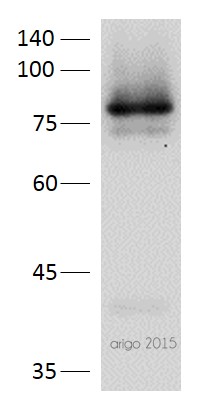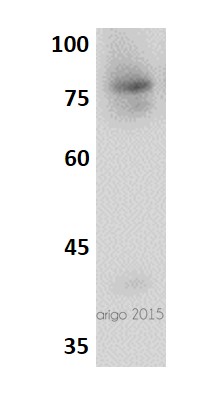ARG54150
anti-STAT3 antibody
anti-STAT3 antibody for Western blot and Human,Mouse,Rat,Hamster
Cancer antibody; Cell Biology and Cellular Response antibody; Developmental Biology antibody; Gene Regulation antibody; Signaling Transduction antibody

3
概述
| 产品描述 | Mouse Monoclonal antibody recognizes STAT3 |
|---|---|
| 反应物种 | Hu, Ms, Rat, Hm |
| 应用 | WB |
| 宿主 | Mouse |
| 克隆 | Monoclonal |
| 同位型 | IgG1 |
| 靶点名称 | STAT3 |
| 抗原物种 | Human |
| 抗原 | Purified recombinant human STAT3 protein fragments expressed in E.coli |
| 偶联标记 | Un-conjugated |
| 別名 | ADMIO; APRF; HIES; Acute-phase response factor; Signal transducer and activator of transcription 3 |
应用说明
| 应用建议 |
|
||||
|---|---|---|---|---|---|
| 应用说明 | * The dilutions indicate recommended starting dilutions and the optimal dilutions or concentrations should be determined by the scientist. |
属性
| 形式 | Liquid |
|---|---|
| 缓冲液 | Ascites |
| 存放说明 | For continuous use, store undiluted antibody at 2-8°C for up to a week. For long-term storage, aliquot and store at -20°C or below. Storage in frost free freezers is not recommended. Avoid repeated freeze/thaw cycles. Suggest spin the vial prior to opening. The antibody solution should be gently mixed before use. |
| 注意事项 | For laboratory research only, not for drug, diagnostic or other use. |
生物信息
| 数据库连接 | |
|---|---|
| 基因名称 | STAT3 |
| 全名 | signal transducer and activator of transcription 3 (acute-phase response factor) |
| 背景介绍 | Signal transducer and transcription activator that mediates cellular responses to interleukins,KITLG/SCF and other growth factors.May mediate cellular responses to activated FGFR1,FGFR2,FGFR3 and FGFR4.Binds to the interleukin-6 (IL-6)-responsive elements identified in the promoters of various acute-phase protein genes.Activated by IL31 through IL31RA.Cytoplasmic STAT3 represses macroautophagy by inhibiting EIF2AK2/PKR activity.Plays an important role in host defense in methicillin-resistant S.aureus lung infection by regulating the expression of the antimicrobial lectin REG3G by similarity. |
| 生物功能 | Signal transducer and transcription activator that mediates cellular responses to interleukins, KITLG/SCF and other growth factors. May mediate cellular responses to activated FGFR1, FGFR2, FGFR3 and FGFR4. Binds to the interleukin-6 (IL-6)-responsive elements identified in the promoters of various acute-phase protein genes. Activated by IL31 through IL31RA. Cytoplasmic STAT3 represses macroautophagy by inhibiting EIF2AK2/PKR activity. Plays an important role in host defense in methicillin-resistant S.aureus lung infection by regulating the expression of the antimicrobial lectin REG3G (By similarity). [UniProt] |
| 细胞定位 | Cytoplasm. Nucleus. |
| 产品亮点 | Related products: STAT3 antibodies; Anti-Mouse IgG secondary antibodies; Related news: LKB1 deficiency in T cells promotes gut tumors |
| 研究领域 | Cancer antibody; Cell Biology and Cellular Response antibody; Developmental Biology antibody; Gene Regulation antibody; Signaling Transduction antibody |
| 预测分子量 | 88 kDa |
| 翻译后修饰 | Tyrosine phosphorylated upon stimulation with EGF. Tyrosine phosphorylated in response to constitutively activated FGFR1, FGFR2, FGFR3 and FGFR4 (By similarity). Activated through tyrosine phosphorylation by BMX. Tyrosine phosphorylated in response to IL6, IL11, LIF, CNTF, KITLG/SCF, CSF1, EGF, PDGF, IFN-alpha, LEP and OSM. Activated KIT promotes phosphorylation on tyrosine residues and subsequent translocation to the nucleus. Phosphorylated on serine upon DNA damage, probably by ATM or ATR. Serine phosphorylation is important for the formation of stable DNA-binding STAT3 homodimers and maximal transcriptional activity. ARL2BP may participate in keeping the phosphorylated state of STAT3 within the nucleus. Upon LPS challenge, phosphorylated within the nucleus by IRAK1. Upon erythropoietin treatment, phosphorylated on Ser-727 by RPS6KA5. Phosphorylation at Tyr-705 by PTK6 or FER leads to an increase of its transcriptional activity. Dephosphorylation on tyrosine residues by PTPN2 negatively regulates IL6/interleukin-6 signaling. Acetylated on lysine residues by CREBBP. Deacetylation by LOXL3 leads to disrupt STAT3 dimerization and inhibit STAT3 transcription activity (PubMed:28065600). Oxidation of lysine residues to allysine on STAT3 preferentially takes place on lysine residues that are acetylated (PubMed:28065600). Some lysine residues are oxidized to allysine by LOXL3, leading to disrupt STAT3 dimerization and inhibit STAT3 transcription activity (PubMed:28065600). Oxidation of lysine residues to allysine on STAT3 preferentially takes place on lysine residues that are acetylated (PubMed:28065600). |
检测图片 (1) Click the Picture to Zoom In
客户反馈
文献引用

 Excellent
Excellent


 Average
Average







